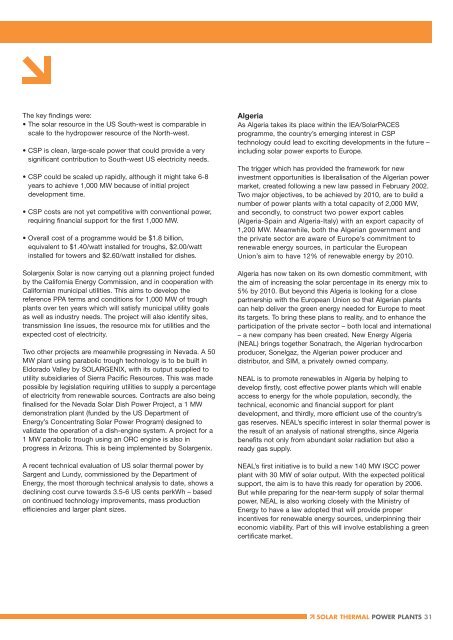solar thermal power - Greenpeace
solar thermal power - Greenpeace
solar thermal power - Greenpeace
You also want an ePaper? Increase the reach of your titles
YUMPU automatically turns print PDFs into web optimized ePapers that Google loves.
The key findings were:<br />
• The <strong>solar</strong> resource in the US South-west is comparable in<br />
scale to the hydro<strong>power</strong> resource of the North-west.<br />
• CSP is clean, large-scale <strong>power</strong> that could provide a very<br />
significant contribution to South-west US electricity needs.<br />
• CSP could be scaled up rapidly, although it might take 6-8<br />
years to achieve 1,000 MW because of initial project<br />
development time.<br />
• CSP costs are not yet competitive with conventional <strong>power</strong>,<br />
requiring financial support for the first 1,000 MW.<br />
• Overall cost of a programme would be $1.8 billion,<br />
equivalent to $1.40/watt installed for troughs, $2.00/watt<br />
installed for towers and $2.60/watt installed for dishes.<br />
Solargenix Solar is now carrying out a planning project funded<br />
by the California Energy Commission, and in cooperation with<br />
Californian municipal utilities. This aims to develop the<br />
reference PPA terms and conditions for 1,000 MW of trough<br />
plants over ten years which will satisfy municipal utility goals<br />
as well as industry needs. The project will also identify sites,<br />
transmission line issues, the resource mix for utilities and the<br />
expected cost of electricity.<br />
Two other projects are meanwhile progressing in Nevada. A 50<br />
MW plant using parabolic trough technology is to be built in<br />
Eldorado Valley by SOLARGENIX, with its output supplied to<br />
utility subsidiaries of Sierra Pacific Resources. This was made<br />
possible by legislation requiring utilities to supply a percentage<br />
of electricity from renewable sources. Contracts are also being<br />
finalised for the Nevada Solar Dish Power Project, a 1 MW<br />
demonstration plant (funded by the US Department of<br />
Energy’s Concentrating Solar Power Program) designed to<br />
validate the operation of a dish-engine system. A project for a<br />
1 MW parabolic trough using an ORC engine is also in<br />
progress in Arizona. This is being implemented by Solargenix.<br />
A recent technical evaluation of US <strong>solar</strong> <strong>thermal</strong> <strong>power</strong> by<br />
Sargent and Lundy, commissioned by the Department of<br />
Energy, the most thorough technical analysis to date, shows a<br />
declining cost curve towards 3.5-6 US cents perkWh – based<br />
on continued technology improvements, mass production<br />
efficiencies and larger plant sizes.<br />
Algeria<br />
As Algeria takes its place within the IEA/SolarPACES<br />
programme, the country’s emerging interest in CSP<br />
technology could lead to exciting developments in the future –<br />
including <strong>solar</strong> <strong>power</strong> exports to Europe.<br />
The trigger which has provided the framework for new<br />
investment opportunities is liberalisation of the Algerian <strong>power</strong><br />
market, created following a new law passed in February 2002.<br />
Two major objectives, to be achieved by 2010, are to build a<br />
number of <strong>power</strong> plants with a total capacity of 2,000 MW,<br />
and secondly, to construct two <strong>power</strong> export cables<br />
(Algeria-Spain and Algeria-Italy) with an export capacity of<br />
1,200 MW. Meanwhile, both the Algerian government and<br />
the private sector are aware of Europe’s commitment to<br />
renewable energy sources, in particular the European<br />
Union’s aim to have 12% of renewable energy by 2010.<br />
Algeria has now taken on its own domestic commitment, with<br />
the aim of increasing the <strong>solar</strong> percentage in its energy mix to<br />
5% by 2010. But beyond this Algeria is looking for a close<br />
partnership with the European Union so that Algerian plants<br />
can help deliver the green energy needed for Europe to meet<br />
its targets. To bring these plans to reality, and to enhance the<br />
participation of the private sector – both local and international<br />
– a new company has been created. New Energy Algeria<br />
(NEAL) brings together Sonatrach, the Algerian hydrocarbon<br />
producer, Sonelgaz, the Algerian <strong>power</strong> producer and<br />
distributor, and SIM, a privately owned company.<br />
NEAL is to promote renewables in Algeria by helping to<br />
develop firstly, cost effective <strong>power</strong> plants which will enable<br />
access to energy for the whole population, secondly, the<br />
technical, economic and financial support for plant<br />
development, and thirdly, more efficient use of the country’s<br />
gas reserves. NEAL’s specific interest in <strong>solar</strong> <strong>thermal</strong> <strong>power</strong> is<br />
the result of an analysis of national strengths, since Algeria<br />
benefits not only from abundant <strong>solar</strong> radiation but also a<br />
ready gas supply.<br />
NEAL’s first initiative is to build a new 140 MW ISCC <strong>power</strong><br />
plant with 30 MW of <strong>solar</strong> output. With the expected political<br />
support, the aim is to have this ready for operation by 2006.<br />
But while preparing for the near-term supply of <strong>solar</strong> <strong>thermal</strong><br />
<strong>power</strong>, NEAL is also working closely with the Ministry of<br />
Energy to have a law adopted that will provide proper<br />
incentives for renewable energy sources, underpinning their<br />
economic viability. Part of this will involve establishing a green<br />
certificate market.<br />
SOLAR THERMAL POWER PLANTS 31

















